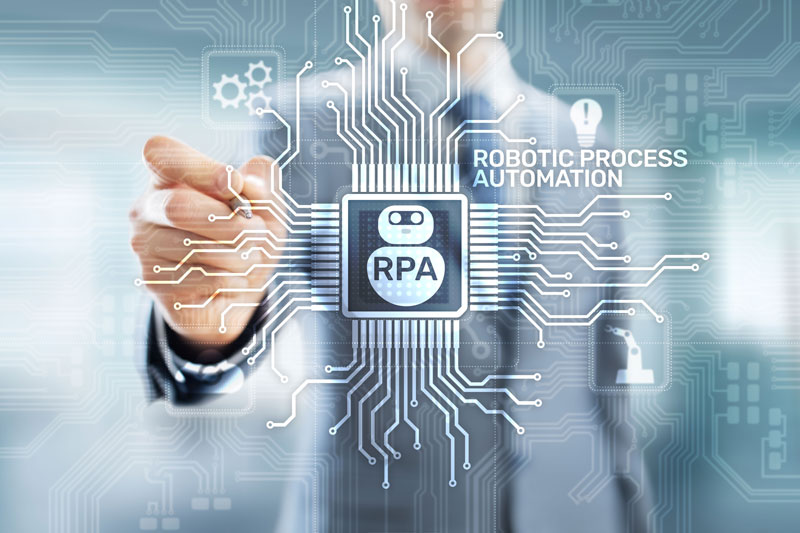Today, with advanced technologies, the data entry process has undergone significant changes. Data entry can now be made even more efficient and hassle-free with Robotic Process Automation (RPA). Repetitive and tedious work that takes up several working hours is a waste of time and productivity. But these activities can be replaced by RPA which helps to save costs, automate workflow and improve the overall productivity of the organization. Many enterprises are now integrating RPA into their hardware and software so that there is a total and comprehensive improvement in operational efficiencies and customer service. To make your data entry process easier, outsource to a business process outsourcing company which can help integrate RPA and thereby achieve a higher degree of accuracy, as well as improve efficiency and productivity in the organization.
RPA (Robotic Process Automation) is an increasingly popular tool, that can streamline routine business processes and enhance manual capabilities. It involves a software robot that works like a human operator and uses a computer program that seamlessly integrates and enhances existing business processes, technologies, and operations. It helps to quickly perform routine tasks that used to take hours and even days. Today, RPA is used in many industries such as healthcare, financial services, insurance, and many other sectors where routine tasks can be completed quickly.
How RPA Helps Manual Data Entry
When an organization requires employees to manually input data, there is the risk of errors. However, with the advent of Robotic Process Automation (RPA) solutions, businesses have been able to handle manual tasks at a much faster pace. RPA technologies have an important role to play in facilitating automated data entry processes that are accurate and complete, thus leading to high levels of efficiency. It can free up time and capital that otherwise would be spent on mundane, data entry-related tasks, and use those for core processes. It is a great alternative for an organization that cannot afford to make a full transition to automation or doesn’t have the tech know-how.
Some of the advantages of RPA in the data entry process include the following:
- Ensures quick data collection and compilation into one format when large volumes of data flow in from different sources.
- Provides a high level of accuracy that complements the structured data entry by humans
- Ensures excellent data quality, integrity and consistency and meets high standards in the data entry process by eliminating any errors.
- RPA is used in many data related operations like data extraction, data cleansing, data de- duplications, data mining and data enrichment.
- RPA automates the tedious and time-consuming task of entering data, and this helps the same workers to focus on other business activities that add value to the enterprise.
- The manual process of data entry to reporting generation becomes seamless with RPA.
- With RPA, data entry operators can ensure a higher level of accuracy in areas like rekeying that is prone to errors. This is because RPA can automate certain stages of the process thereby enabling human operators to take considered and intelligent decisions during the manual data entry cycle.
- Links external systems to ensure better coordination and productivity
- Helps to avoid errors and promote quality and consistency and thus ensure good data integrity throughout the process
Securing Data with RPA
Today, companies have modern IT systems that capture data and integrate it into their applications. This helps developers to input user filled forms directly into the backend system. It removes any potential human mistake when employees handle and process sensitive data. When you deal with huge volumes of data, there is always a chance of security breach but with RPA you can log in and record with security; and the records can be reviewed step-by-step to spot any issues or vulnerabilities. This helps in proving compliance and due diligence in an audit scenario.
Improve Legacy Systems with RPA
RPA helps to extract data from any form. It helps with form processing, image processing; processes the information and transfers data to RPA bot. Using this output method, RPA bots can easily transfer data into a legacy system. RPA software robots can read information on screens and the robots are better at adapting to the application changes that used to hamper their performance. It helps to bridge siloed applications and get more value from existing technologies while also helping employees assign mundane work to software robots.
Companies can utilize data entry services from an agency that is well aware of the basics of the data entry process and can check the accuracy of data, and also ensure that the reports generated are in the desired format and structure. Data entry may still require human insight and interference. Therefore, the role of RPA is to ensure that manual data entry is supported with a degree of automation an agency that is well aware of the basics of the data entry process and can check the accuracy of data, and also ensure that the reports generated are in the desired format and structure. Data entry may still require human insight and interference. Therefore, the role of RPA is to ensure that manual data entry is supported with a degree of automation.
Data entry has been around for decades and it is still one of the most pivotal aspects of businesses, especially in today’s day and age. With so many businesses and corporations storing crucial information online, it is essential to ensure that the data you have is backed up and completely reliable. Businesses can reach out to a reliable robotic process automation company that can help enhance human capability and improve data entry operations.




